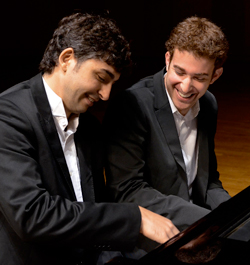by Mike Telin

Protégés of Zubin Mehta, Haroni and Kohlberg initially came together as a duo piano team for a peace concert at the Oslo House in Norway in 2011. In a recent interview, Kohlberg said the musical connection between himself and Haroni was “so strong” they felt they needed to continue the musical partnership. And shortly thereafter Duo Amal – Amal being the Arabic word for “hope” — was formed.
In addition to demonstrating their collective musical prowess, Haroni and Kohlberg also proved themselves to be inventive programmers: their program featured a recently commissioned work, and transcriptions as well as staples of the piano four-hands and duo piano repertoire. Beginning with Schubert’s Fantasy in F minor — piano four hands — the performers capitalized on an opportunity to do something a little different: like synchronized swimmers they switched the direction their respective piano benches were facing — just enough comedy to get a laugh from the capacity audience. Quickly turning to the business at hand, Duo Amal brought a romantic freshness to Schubert’s well-known work. With their nuanced phrasing and clarity of sound, the performance was, in a word, delightful.
Written in 2011 and commissioned by Duo Amal, Avner Dorman’s energetic, four-minute Karsilama, a popular Turkish couple’s dance in 9/8 time, is structured as a set of variations with each variation presenting a different way of dancing the compound rhythm. Haroni and Kohlberg played with acute rhythmic accuracy, emphasizing the dance’s physical nature as the work progressed.
The piece also made an excellent prelude to Prokofiev’s Symphony No. 1 (“Classical’) in a dazzling arrangement by Rikuya Tershima. Although there might have been listeners in the audience who had not heard Prokofiev’s masterpiece performed in its original version, Duo Amal’s splendidly polished reading captured the attention like a performance by an outstanding orchestra.
Shostakovich’s Concertino for Two Pianos, op. 94 was written in 1954 for the composer’s son. It was also the only work on the program where one pianist assumed an accompanying role and the other the role of soloist. Written in sonata form with introduction, the work contrasting motives: slow themes followed by a sharply dotted march followed by a quiet hymn-like conclusion. Duo Amal’s performance was full of colors and percussiveness befitting an orchestra.
The final work on the printed program, Rachmaninov’s Suite No. 1 for two pianos, op. 5 is one of the warhorses of the two-piano repertoire. Written in 1893, the 23-minute work musically depicts excerpts of poems by Lermontov, Byron, Tyutchey and Khomyakov. Duo Amal’s playing during the first and second movements, Barcarolle and La nuit… L’amour… (The night…the love…) was purely sublime. The third movement, Les Larmes. (The Tears) was heart-wrenching and the final Pâques (Easter) was full of sonic glory. And as was true of the entire evening, the powerful playing and immense sound Duo Amal is capable of producing never overpowered the warm Reinberger acoustics.
Following a well earned ovation, Haroni and Kohlberg regaled the audience with another work more often associated with the symphony orchestra, Stravinsky’s Russian Dance from his ballet Petrushka. Their splendid playing only further drove home the fact that Duo Amal is a piano duo to watch — and hopefully they’ll be back in Cleveland soon.
Published on ClevelandClassical.com February 27, 2014
Click here for a printable version of this article.


